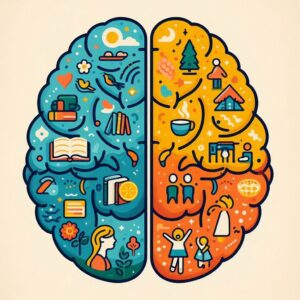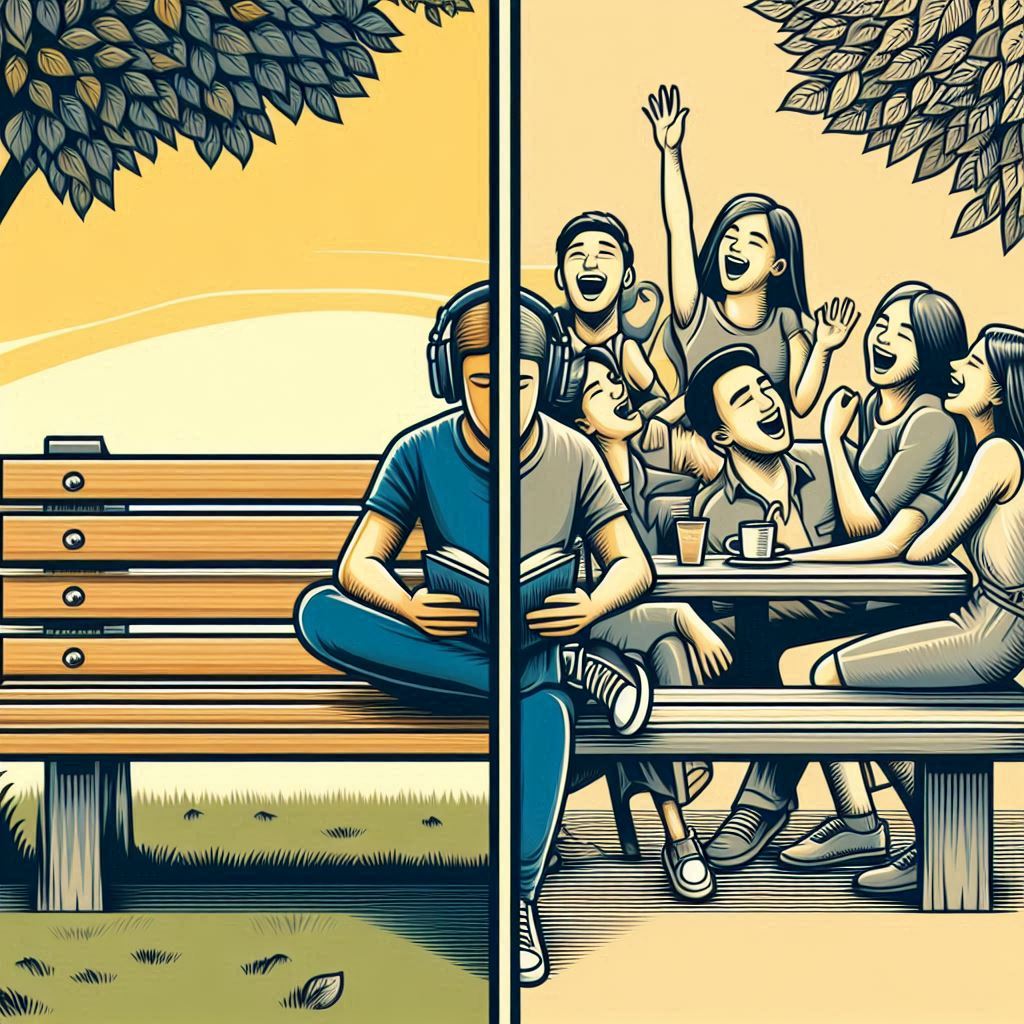Have you ever wondered why some people crave social interaction while others find it draining? The answer lies in our personalities, specifically the spectrum of introversion and extroversion. Understanding these differences can revolutionize how we communicate, build relationships, and function in various social settings.
Demystifying Introversion and Extraversion
Carl Jung, a renowned psychologist, first introduced the concepts of introversion and extroversion in the early 1900s. These terms describe how individuals gain and expend energy.
- Introverts are energized by solitude and introspection. They often need time alone to “recharge” after social interactions, which can be mentally stimulating but draining [1]. Introverts typically prefer deep, meaningful conversations over small talk [2].
- Extroverts, on the other hand, thrive in social settings and draw energy from interacting with others [2]. They enjoy meeting new people, and engaging in lively discussions and might feel restless when alone for extended periods [2].

It’s a Spectrum, Not a Duality
It’s important to remember that introversion and extroversion are not absolutes, but rather a spectrum. Many people fall somewhere in the middle, exhibiting characteristics of both personalities. This is often referred to as ambiversion [3].
Social Preferences: Quiet Contemplation or Animated Interaction?
Introverts generally find comfort in spending time alone or with a small group of close friends. Large gatherings can be overwhelming, prompting a need to retreat and de-stimulate [1]. Conversely, extroverts flourish in social environments. They are the life of the party, often seeking out new connections and reveling in the buzz of social interaction [2].
Energy Sources: Reflecting Inward or Engaging Outward?
The way we gain energy is a key differentiator. Introverts recharge through introspection and quiet activities like reading, writing, or spending time in nature [4]. Social interactions, while stimulating, can deplete their energy reserves. In contrast, extroverts are energized by external stimuli. Social gatherings, group activities, and lively discussions fuel their enthusiasm [4].
Communication Styles: Thoughtful Words or Brainstorming Out Loud?

Communication styles also differ between introverts and extroverts. Introverts tend to be more reserved in their communication. They may take time to formulate their thoughts before speaking and often value thoughtful, well-considered responses [5]. Extroverts, on the other hand, might “think out loud” and express themselves more spontaneously. They enjoy brainstorming ideas with others and may speak more than they listen [5].
Problem-Solving Strategies: Solo Contemplation or Collaborative Brainstorming?
When faced with challenges, introverts prefer to analyze problems internally and come up with solutions independently [6]. This reflective approach allows them to delve deeper and arrive at well-thought-out answers. Extroverts, however, excel at collaborative problem-solving. They thrive on brainstorming sessions and discussions with others. Their willingness to take risks and explore different perspectives can lead to innovative solutions [6].
Embracing the Spectrum for a More Fulfilling Life
Understanding these differences is not about labeling people or creating divisions. It’s about fostering better interactions, appreciating each personality type’s strengths, and creating a more inclusive environment.
Unlock the Secrets: Discover the Fascinating Difference Between Introverted and Extroverted Minds!
How This Knowledge Can Benefit You
- Improved Teamwork: By recognizing introverts’ need for quiet reflection and extroverts’ collaborative spirit, teams can create a balanced work environment where everyone feels valued and heard.
- Effective Leadership: Leaders who understand introversion and extroversion can tailor their communication styles and delegate tasks effectively, ensuring everyone contributes to their fullest potential.
- Stronger Relationships: Knowing your own and your partner’s personality preferences can lead to more fulfilling relationships. Introverts may need to schedule alone time to recharge, while extroverts might crave stimulating conversations and shared activities.
How Do I Know if I Am Introvert or Extrovert?

Ever wonder why some people thrive in social settings while others crave solitude? The answer lies in your personality, specifically where you fall on the spectrum of introversion and extroversion. These terms, popularized by Carl Jung, describe how we gain and expend energy.
Extroverts:
- Energized by People: Extroverts feel alive when surrounded by others. Social interaction is their fuel, and they enjoy meeting new people, engaging in lively discussions, and being the life of the party.
- Crave External Stimulation: Extroverts thrive on external stimuli. Brainstorming sessions, group activities, and bustling environments keep them energized.
Introverts:
- Recharged by Solitude: Introverts find peace and energy in quiet time alone. Social interaction can be stimulating, but it can also be draining. Introverts need time to “recharge” after social events.
- Drawn to Internal Reflection: Introverts gain energy through introspection and quiet activities like reading, writing, or spending time in nature.
Remember: It’s a Spectrum, Not a Duality
It’s important to remember that introversion and extroversion are not absolutes, but rather a spectrum. Many people, often referred to as ambiverts, fall somewhere in the middle, exhibiting characteristics of both personalities.
Identify Your Preferences
Here are some questions to ponder:
- Do you feel energized or drained after spending time with a large group of people?
- Do you prefer deep, meaningful conversations or lighthearted small talk?
- How do you recharge after a busy day?
By reflecting on your preferences for social interaction, stimulation, and alone time, you can gain a better understanding of where you lie on the introversion-extroversion spectrum.
Which Is Better, Introvert or Extrovert?

When it comes to determining whether being an introvert or an extrovert is better, it’s important to understand that both personality types have unique strengths and advantages. The key lies in appreciating the difference between introverted and extroverted traits and how they contribute to various aspects of life.
Strengths of Introverts
- Deep Thinking: Introverts often excel in fields that require deep concentration and problem-solving abilities. They can provide thoughtful insights and innovative solutions.
- Listening Skills: Introverts are great listeners, making them valuable in roles that require understanding and empathy, such as counseling or customer service.
- Independence: Introverts are comfortable working independently, which can be a significant advantage in remote work environments or tasks requiring minimal supervision.
Strengths of Extroverts
- Social Connectivity: Extroverts build extensive networks and are skilled at forming connections, making them ideal for sales, marketing, and public relations roles.
- Energy and Enthusiasm: Extroverts bring energy and enthusiasm to group settings, boosting team morale and fostering a positive work environment.
- Adaptability: Extroverts are often quick to adapt to new situations and enjoy exploring new opportunities, which can be beneficial in dynamic and fast-paced industries.
Finding Balance
Neither introversion nor extroversion is inherently better. The best approach is to recognize and leverage your natural tendencies while developing skills associated with the opposite trait. For example, introverts can practice social skills to enhance their networking abilities, while extroverts can work on cultivating moments of solitude to improve focus and introspection.
The Takeaway
Introversion and extroversion are not about being better or worse; they are simply different ways of interacting with the world. By appreciating these differences and building bridges between introverts and extroverts, we can cultivate a more understanding and harmonious world.
Statistics
- A study published in the Journal of Personality and Social Psychology suggests that introverts constitute just under 50% of the population, while extroverts account for approximately 50% [7]. The remaining portion falls somewhere in the middle of the spectrum.
References
- Choosing Therapy (https://thewell.northwell.edu/emotional-wellness/introvert-extrovert-mental-health)
- Psychology Today (https://www.psychologytoday.com/us/blog/cutting-edge-leadership/201711/are-you-extravert-introvert-or-ambivert)
- Simply Psychology (https://www.simplypsychology.org/introvert-extrovert.html)
- Crystal Knows (https://www.crystalknows.com/crystal-for-introverts)
- The Myers-Briggs Company (https://www.themyersbriggs.com/en-US/Connect-With-Us/Blog/2022/December/How-those-with-Introversion-preferences-manage-conflict)
- Journal of Personality and Social Psychology (https://psycnet.apa.org/record/1926-07832-001)

